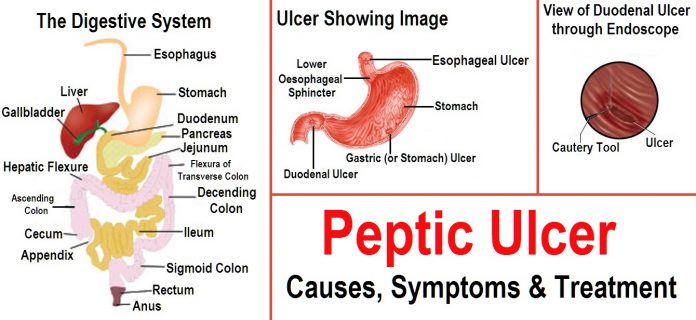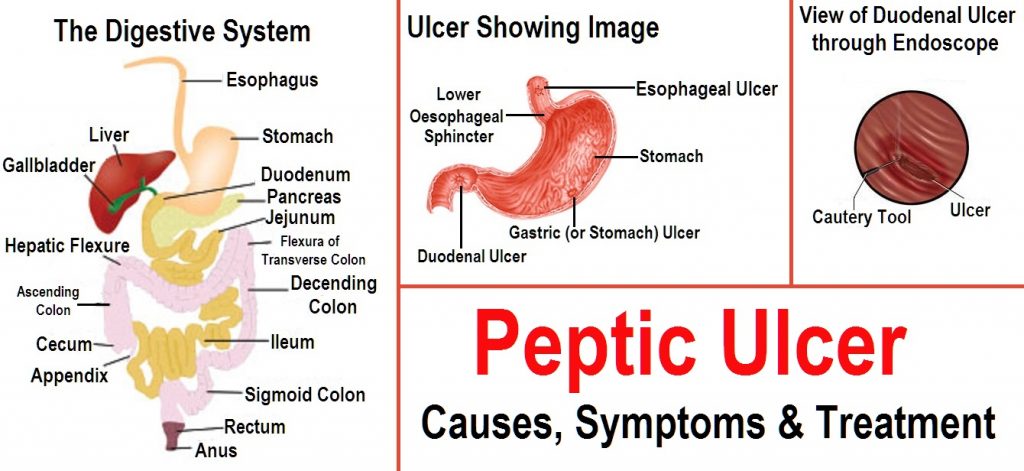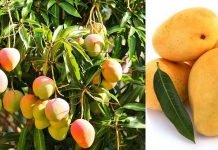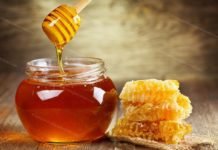

Ulcer is a wound which happens in one of the internal surfaces of digestive tract. It can occur anywhere from the mouth to the rectum of the digestive tract. These internal surfaces are called the “Mucosa” which is a thin membrane coated with a sticky liquid called the “Mucus”. The digestive tract starts at the mouth, and continues through the oesophagus (gullet), stomach, small intestine, large intestine, rectum and ends at the anus.
When an ulcer occurs in the digestive tract which contains pepsin and acid, it is called peptic ulcer.
Peptic ulcer may occur in the stomach or in the first part of the small intestine called the “duodenum”. Sometimes it may form in the lower end of oesophagus and rarely past the duodenum. The most common places the peptic ulcer form are in stomach known as the “Gastric ulcers” and in duodenum known as the “Duodenal ulcers”.
In India duodenal ulcers are found thirty times more than gastric ulcers.
Peptic ulcers may be present for weeks and months and may become up to a depth of 1 cm. When the mucosa is destroyed, the dead cells are found on the top of the ulcer, which is whitish yellow in colour and is called ulcer slough. The tissue tries to repair itself and hence the deeper layer of the ulcers is made up of the scar tissue that has formed.
The Upper Digestive Tract:
The digestive tract is a long muscular tube with an internal covering of mucosa. The mucosa is lubricated by mucus to help food to pass easily. It has a stronger external coating called the serosal membrane.
The Oesophagus:
What we eat and drink passes via the mouth into the oesophagus and take about three seconds to reach the stomach. The action of the muscles within the wall of the oesophagus helps the swallowing function, and also squeezes the contents of gullet in a regular and rhythmical action. This squeezing contraction is called peristalsis and this continues all the way through the digestive tract. Peristalsis occurs automatically.
At the bottom of the oesophagus, it goes through the diaphragm; the oesophagus closes completely so that the contents of the stomach do not return to the oesophagus, even if you stand on your head. The part where the oesophagus joins the stomach is called the cardia.
Stomach:
Below the cardia is the stomach. It is about 8-12 inches long and lye slightly to the left. It passes down the abdomen and then bends towards the right side and ends there. Below the stomach is the duodenum.
The stomach is made up of different parts. The inner surface is called the mucosa which consists of a folded top layer of cells which gives an uneven surface. The cells in the mucosa produce mucus.
There are also other specialized cells that produce important functions in the various parts of the stomach. The specialized cells and the muscle are partly controlled by the nerves which come through the serosal membrane. The Vagus nerve is most important of the nerves which begin in the brain.
The stomach tissue needs blood to supply oxygen and food materials.
The uppermost part of the stomach is called the fundus and the next part is the body which is followed by the antrum.
The mucosa of the fundus and the body contains two types of the important specialized cells. The first type is the Parietal Cells (or Oxyntic cells), produces large amounts of hydrochloric acid, which makes the gastric juice and makes the contents of the stomach acidic. If excess amounts of gastric juice enter the oesophagus, it may result in pain and inflammation which is called esophagitis. The second type is the Peptic Cells which produce a chemical called the Pepsinogen. This is changed as Pepsin, inside the stomach and this pepsin acts as an enzyme which breakdown the proteins into amino acids and also helps in the digestive process. Acid and pepsin together digest the food.
The antrum has G-cells, which produces a hormone called gastrin. It stimulates the parietal and peptic cells to release hydrochloric acid and pepsin into the stomach.
The Duodenum:
Pylorus is the narrow exit from the stomach to the duodenum. The next part is the small intestines. The mucosa cells in the duodenum produces an alkali called the bicarbonate which helps to neutralize the acidity of the fluid coming into the duodenum from the stomach.
Ulcer Occurring Sites:
Gastric ulcers can occur anywhere in the stomach, yet the most common place is where the stomach’s body and antrum meet. Then is antrum, near the Pylorus, below the cardia etc.
Peptic ulcers mostly occur on the first part of the duodenum, called the bulb.
Causes of Ulcer:
* Taking beverages like coffee and tea very hot and strong may cause peptic ulcer.
* Some drugs like aspirin and other pain killers are told to cause peptic ulcer.
* Stress, emotional problems, financial worries cause indigestion which may lead to ulcer.
* Eating foods very hot and spicy.
* Drinking water in-between while eating food.
* Eating in a hurry.
* Smoking and alcohol consumption.
Symptoms:
* Pain – Pain is the most common symptom. The pain may be slight hunger pain to severe like piercing a knife.
* Nausea.
* Vomiting.
* Loss of appetite which leads to loss of weight.
* Heart burn.
* Diarrhoea (rarely)
* A bitter, frothy fluid comes into the mouth from the stomach known as the water brash.
Treatment:
* Eat a normal, balanced diet and have regular meals.
* Avoid smoking and drinking alcohol.
* Get treatment for constipation, if you get it.
* Avoid eating spicy and masala items.
* Avoid doing work without rest.
Surgical Treatment:
If ulcer continues or if complications develop, surgical treatment may be necessary. The two main types of operation are Partial Gastrectomy and Vagotomy.
In Partial Gastrectomy, the lower part of the stomach is removed including the antrum and the duodenum or jejunum is joined to the remaining upper stomach.
In Vagotomy, the branches of the vagus nerve which stimulate gastric acid production are cut. In Vagotomy also there are two types, “Truncal Vagotomy” where these branches are cut just where they enter the abdomen through the diaphragm and “Selective Vagotomy” where only those nerve fibres supplying the stomach are cut.
Complications of Ulcer:
1. Bleeding:
The walls of the stomach and duodenum are supplied with blood vessels and if an ulcer burrows into any of these vessels, internal bleeding occurs.
2. Perforation:
Perforation means an ulcer burrows completely through the wall of the stomach or duodenum. The content of the stomach or duodenum would leak in to the abdominal cavity and cause very severe pain and immediate hospitalization is required.
3. Pyloric Stenosis:
When ulcer occurs in or around the narrow outlet at the lower end of the stomach called Pylorus, sometimes it may cause swelling which will lead to the blockage in the pyloric canal. This is known as Pyloric Stenosis. Due to this, the gastric juices and indigested foods and liquids are unable to pass into the duodenum and thus they accumulate in the stomach. The main symptom is repeated vomiting.
Natural Medicines:
* Tender coconut water, carrot juices are good for peptic ulcer.
* Eating Pomegranate, Red banana, sapodilla fruit is also good.
* Raw juice of greens is also good.


![Licorice Medicinal Uses, Health Benefits, Natural Home Remedies [ Glycyrrhiza glabra ] Liquorice Licorice Medicinal Uses](https://www.onlinekanyakumari.com/wp-content/uploads/2019/08/Licorice-Medicinal-Uses-218x150.jpg)








![Nagercoil Park has many Attractions that you may not know! [Sir C P Ramasamy Iyer Memorial Park | Nagercoil Dinosaur Park | Nagercoil Kids Park] Nagercoil Park](https://www.onlinekanyakumari.com/wp-content/uploads/2022/12/Nagercoil-Park-Selfie-Point-Tree-Balcony-Kids-Park-1-218x150.jpg)





